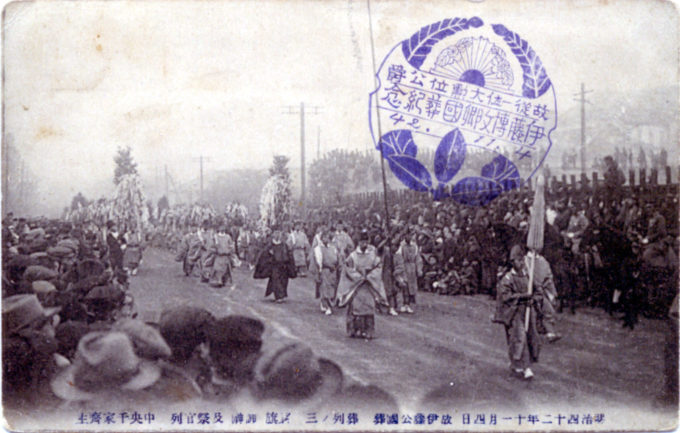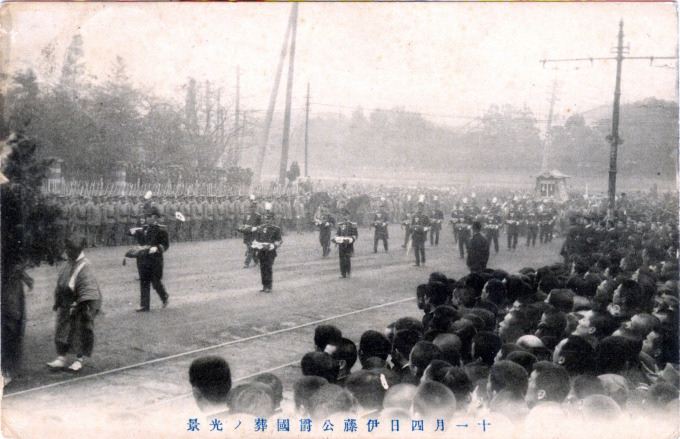
Prince Ito Hirobumi’s funeral procession, Nov. 4, 1909. Ito was revered in Japan as father of the first constitution and its parliamentary democracy. But, he was despised in Korea as the personification of Japan’s colonial imperialism of the Korean peninsula in Ito’s role as the colony’s first administrator-general. Ito was assassinated at Harbin, Manchuria, by a Korean nationalist patriot, An Chung-gun, on Oct. 26, 1909. Between 1963-1989, an engraving of Ito would appear on the ¥1000 note.
“The establishment of the protectorate [in 1905, after Japan’s defeat of Russia] placed Korea in much the same relation to Japan that Egypt bore to England when the latter intervened in the Nile country in 1882. Japan could no more take the risk of another power gaining a foothold in Korea, and thereby threatening her causeway to the Asian mainland, than England could take the risk of another power gaining a foothold in Egypt, and threatening her sea-road to India.
“… England sent to Egypt, as proconsul, her greatest administrator, Evelyn Baring, later Lord Cromer. Japan sent to Korea her greatest administrator, Marquis Ito. Each was confronted with the same problem: to reform a government rotten to the very core, and to effect the regeneration of a people reduced to the lowest depths of misery and degradation be centuries of spoliation and oppression.
“Had Ito not fallen by the bullet of a Korean assassin, at the very moment when the patient, tactful, sympathetic administration which he had established was beginning to show results, there is little doubt that he would have met with an astonishing success in rehabilitation the Land of the Morning Calm as Cromer did in the Land of the Valley of the Nile.
“… The imperial rescript proclaiming the annexation [in 1910, after Ito’s assassination] was the signal for the systematic Japanization of Korea to begin. And it was begun with all the method and thoroughness so characteristic of the people of Nippon. The conciliatory policy of Marquis Ito gave way to the Bismarckian policy of blood and iron.”
– Japan’s Policy in Korea, by E. Alexander Powell, The Atlantic Monthly, March 1922
“Prince Itō Hirobumi was a Japanese statesman and genrō. A London-educated samurai of the Chōshū Domain and an influential figure in the early Meiji Restoration government, he chaired the bureau which drafted the Meiji Constitution in the 1880s. In 1885 he became Japan’s first Prime Minister. He went on to hold the position four times, becoming one of the longest serving prime ministermeijis in Japanese history, and wielded considerable power even out of office as the occasional head of Emperor Meiji’s Privy Council. (In 1889, Ito also became the first genrō, the retired elder Japanese statesmen who were considered the ‘founding fathers’ of modern Japan.)
“Itō’s foreign policy was ambitious. He strengthened diplomatic ties with Western powers including Germany, the United States and especially the United Kingdom. In Asia he oversaw the First Sino-Japanese War and negotiated Chinese surrender on terms aggressively favourable to Japan, including the annexation of Taiwan and the release of Korea from the tribute system.
“The Japan–Korea Treaty of 1905 made Itō the first Japanese Resident-General of Korea. He initially supported the sovereignty of the indigenous Joseon monarchy as a protectorate under Japan, but he eventually accepted and agreed with the increasingly powerful Imperial Japanese Army, which favoured the total annexation of Korea, resigning his position as Resident-General and taking a new position as the President of the Privy Council of Japan in 1909. Four months later, arriving at the Harbin Railway Station for a meeting with Vladimir Kokovtsov, a Russian representative in Manchuria, Itō was assassinated by Korean nationalist An Jung-geun.
“Korea would be forcibly annexed by Japan in 1910, the year following Ito’s assassination.
“A portrait of Itō Hirobumi was on the Series C ¥1,000 note of Japan from 1963 until a new series was issued in 1984. His former house is preserved as a museum near the Shōin Jinja, in Hagi city, Yamaguchi prefecture.”
– Wikipedia


